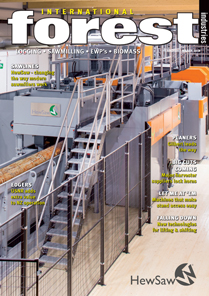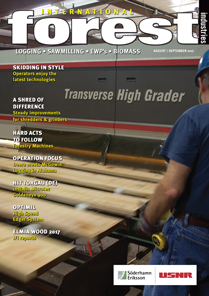EDITOR’S COMMENT ISSUE 61 FEB/MAR 2018 
Sky is the limit
Demand for wood could surge if high-rise timber buildings become the new norm.
The forces behind what is likely to be the world’s tallest timber building have been on a marketing campaign recently on behalf of our industry, and we should be hugely thankful for their efforts.
Moelven Limtre AS is constructing what it calls ‘Mjøstårnet’, an 81 m high-rise building in Brumunddal, an hour-and-a-half northeast of Oslo, Norway’s capital city. When completed, it will be taller than any other wood-based construction in the world and will defy many conventional views on how high-rise buildings should be engineered.
The project is the vision of Moelven Director Rune Abrahamsen, who has a track record of operating outside accepted norms. He believes ‘Mjøstårnet’ is simply an early example of what’s possible for high-rise timber construction.
“With a wider building, it will be possible to build a timber building taller than 100 m; 150 m should also be possible,” Abrahamsen said. “Possibly even taller.”
And he isn’t the only one up to this caper. Abrahamsen says that a number of players are vying for the world record for the world’s tallest timber building and has called for a proper definition of a high-rise timber building to ensure a level playing field.
Not surprisingly, the concept has political support. Sverre Tiltnes, Director of the Norway government’s vehicle for sustainable development, Bygg21, was glowing in his assessment of such projects, having been willingly convinced of their structural merit.
“Unfortunately, many industry players have previously had an unfounded fear that wood has poor load-bearing properties and high risks in the event of fire,” he said. “Mjøstårnet is contributing to more people realizing that wood is very safe with regard to fire and has a load bearing capacity that allows for significant heights.
“Together with [a] recently launched digital guide for the use of industrial wood structures, I believe the upcoming world record of 81 m is just the start of a megatrend.”
There is logic behind this prediction.
If Mjøstårnet and structures to follow prove safety and structural integrity up to, say, 200 m – which based on Abrahamsen’s assessments is not too far away – there are few reasons to prefer concrete and steel, while there is one huge benefit to wood.
Governments will, of course, be champing at the bit to provide a smooth road to construction for these projects in order to meet growing sustainability objectives.
“The project is an important contribution to make the international building industry more environmentally friendly,” Tiltnes said.
It is not difficult to draw the parallel between wood use in construction today and the emergence of hybrid vehicles then fully electric vehicles in the past decade. EVs have been heavily subsidised by governments in a bid to promote more sustainable living in an energy revolution that could definitely be termed a “megatrend”. The uptake of timber in high-rise structures could do something similar.
The impact that would have on raw material and processed timber demand would be immense.
Even if the effect is a fraction of what bureaucrats would like to see, Abrahamsen and Mjøstårnet will have, at the very least, reinforced the versatility and value of wood and its role at the centre of the construction industry.
He deserves a pat on the back for that, if nothing else.
Enjoy
Chris Cann







